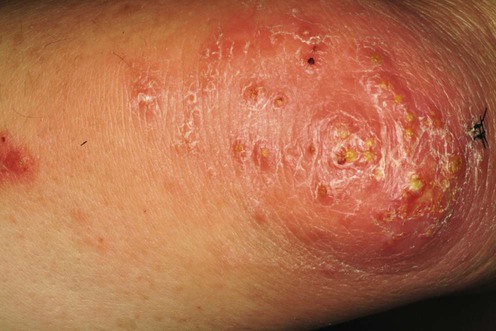Mycobacterium marinum infection of the hand and wrist. Cheung JP, Fung B, Wong SS, Ip WY. J Orthop Surg 2010; 18: 98–103.
Mycobacterial (atypical) skin infections

Get Clinical Tree app for offline access
Fish tank (swimming pool) granuloma
First-line therapies
Third-line therapies
![]()
Stay updated, free articles. Join our Telegram channel

Full access? Get Clinical Tree







 Minocycline 100–200 mg once daily for 6–12 weeks
Minocycline 100–200 mg once daily for 6–12 weeks Doxycycline 100 mg twice daily for 3 to 4 months
Doxycycline 100 mg twice daily for 3 to 4 months Clarithromycin 500 mg once or twice daily for 3 to 4 months
Clarithromycin 500 mg once or twice daily for 3 to 4 months Rifampin 600 mg and ethambutol 1.2 g daily for 3 to 6 months
Rifampin 600 mg and ethambutol 1.2 g daily for 3 to 6 months Co-trimoxazole 2–3 tablets twice daily for 6 weeks
Co-trimoxazole 2–3 tablets twice daily for 6 weeks Clarithromycin 250 mg twice daily and ethambutol 800 mg once daily for 2 to 6 months
Clarithromycin 250 mg twice daily and ethambutol 800 mg once daily for 2 to 6 months Ciprofloxacin 500 mg + clarithromycin 250 mg twice daily for 4 months
Ciprofloxacin 500 mg + clarithromycin 250 mg twice daily for 4 months Rifabutin 600 mg + clarithromycin 500 mg twice daily + ciprofloxacin 500 mg twice daily for 4 months
Rifabutin 600 mg + clarithromycin 500 mg twice daily + ciprofloxacin 500 mg twice daily for 4 months Azithromycin 500 mg three times a week for 2 months
Azithromycin 500 mg three times a week for 2 months Simple excision
Simple excision Curettage and electrodesiccation
Curettage and electrodesiccation Incision and drainage
Incision and drainage Heat therapy by gloves, hot water or heated armlet
Heat therapy by gloves, hot water or heated armlet Photodynamic therapy
Photodynamic therapy Cryotherapy
Cryotherapy Adjunctive anti-TNF-α inhibitors
Adjunctive anti-TNF-α inhibitors